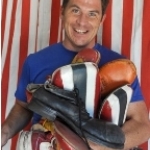
Paul Miller
Circus Mojo - Part Two
Posted by May 19, 2011 1 comment

Paul Miller
Circus as an industry has been incredibly exploitative.
When I joined the circus as a college drop-out in the late 1990s, the Soviet Union fell and with it, went their highest art form—the circus. Their amazing artists had no support from the government, so American circuses enticed these talented individuals to come to the United States. They were paid thousands of rubles which seemed like a lot of money but was, in fact, only about $50 per week. This is not unusual.
I’ve worked with many Russian and Asian circus teachers who can barely read or write. In 2000, I had a six-month gig in Japan with a fellow performer who could speak seven languages but his agent stole half his fee because he could not read the contract.
I am not interested in making a huge profit and exploiting those I work with. That’s the first reason I chose the Low Profit Limited Liability (L3C) structure. The second, is many of the people who helped me form my ideas and test my theories should and do own a piece of equity in my business. The L3C structure allows for member/owner control with majority ownership while including other investor groups. Emmanuel Tawiah, one of my former students, is now my teaching and performing partner. He is from Ghana and is also a member/owner in Circus Mojo and The Institute of Social Circus & Vocational Training Center L3C.
Foundations, individuals, and governmental entities can invest and seek a return of their capital and receive income with the L3C structure. The pressure is on nonprofits to create income generating revenue streams. I believe the days of going to a foundation and proving you are spending their grant dollars responsibly are numbered.
The market potential for circus programming in what is known as the Out of School Time (OST) industry is huge. My friend Jacqueline Davis, who is studying the impact circus has on/for youth at Harvard states, “While there are 6.5 million young people in OST programs, there are 14.3 million who are not (NIOST, 2009); how many might be served by an increased youth circus presence?”
Circus Mojo has also implemented programs for underserved groups beyond the OST market. We offer programs for aging adults and those with mental and physical disabilities such as teaching a woman in her seventies how to spin a plate even though she lost her ability to walk after being stricken with polio at age twelve. With the baby boom generation now coming of age, this is a huge growth market.
A Cost Effective Circus
Hospitals in the United States spend enormous sums on marketing, staff retention, and customer service and we offer programming at hospitals to target those areas. We make the patients happy and teach them new skills (juggling, plate-spinning, hat tricks etc.) that go home with them along with their scar, prescription, and/or cast. When the parents start laughing and begin to engage with us, the young patients see their parents relax and they heal quicker. Most importantly, we aid the human resources department. When we roll into a packed waiting room, everyone from the administrator at the desk to the nurse and the doctor and the business director (when the customer survey results are received) is delighted.
Creating Taxpayers
We work with kids in the juvenile detention system and get amazing results by offering programming that is demanding and provides immediate results. As a case comparison, we recently offered 12 hours of classes for a group identified as “gifted.” In this class, it took us eleven hours of instruction to get all the kids spinning plates. Meanwhile at the detention center, it took us twenty minutes to achieve the same results. The clearest outcome we have is turning a person who is locked up and costing tax payers money into an individual who is out of jail, working productively and paying taxes via working for a circus. This is all possible—we are doing the work.
This work is utilized worldwide for street kids in Indonesia, Ethiopia, and Columbia circus is a means of economic empowerment.
Profit is proof that your system works, however a high profit on the backs of disabled people and kids coming out of jail would replicate the exploitive circus of yesterday. I believe the L3C model of linking multiple pools of capital and keen investors seeking A HIGH IMPACT and low profit is the future providing social change, saving money, and creating jobs.


Comments
Read the study here http://bit.ly/DAVISAYCOSTUDY Thanks Jackie & The American Youth Circus Organization!